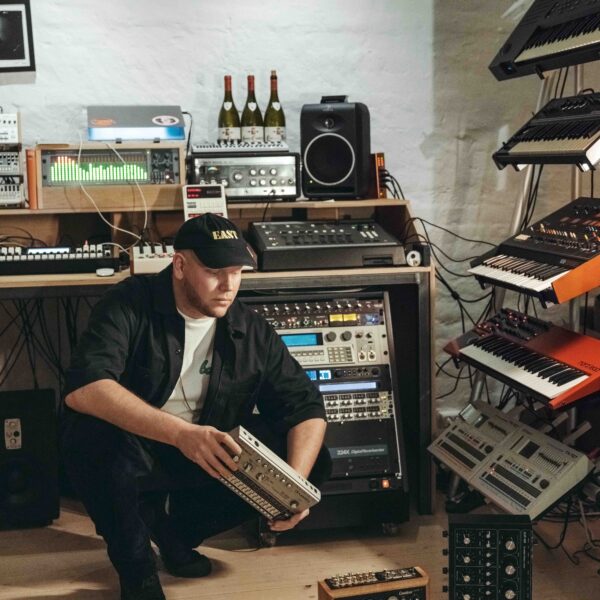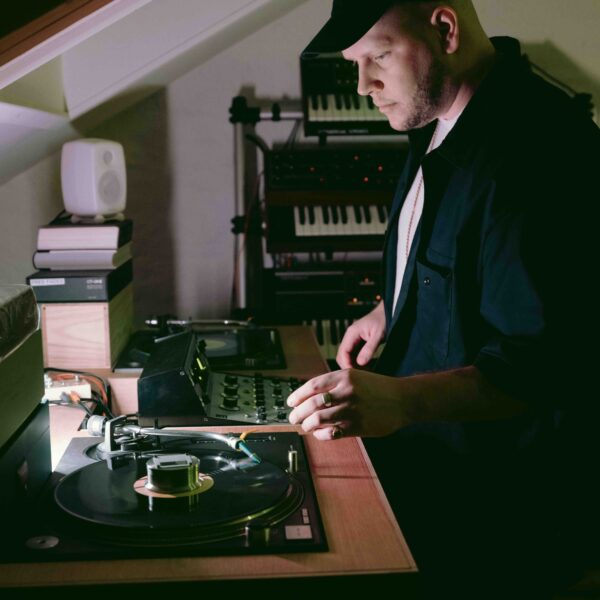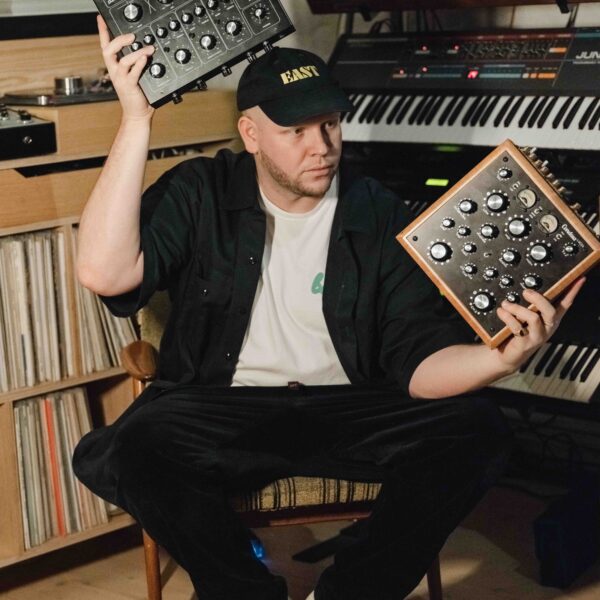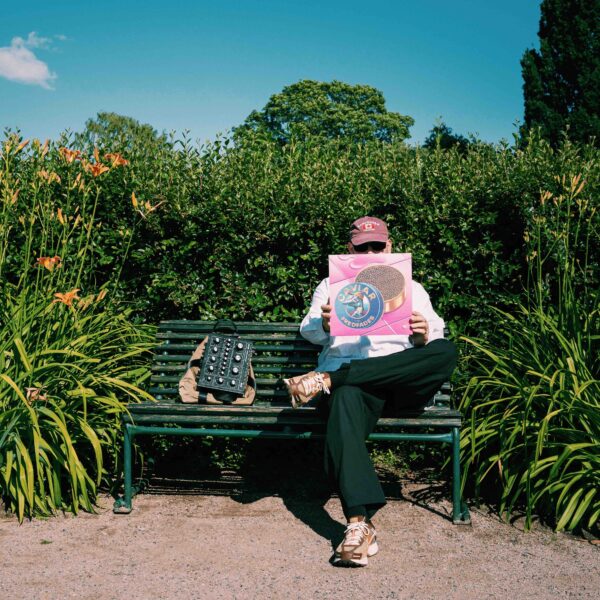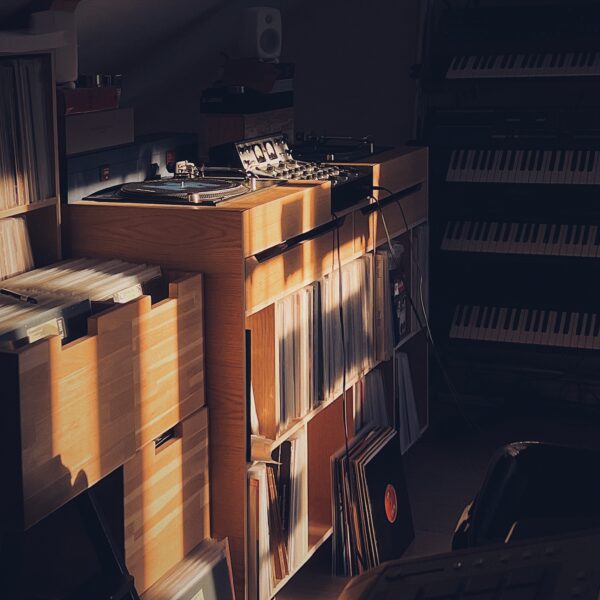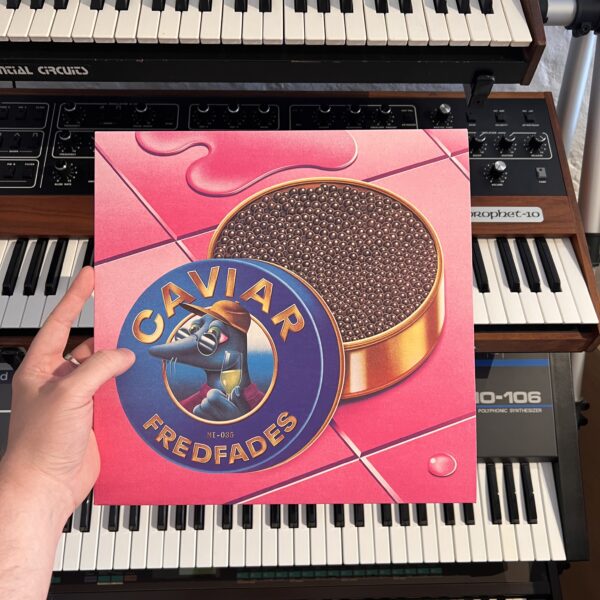Fredfades is a prolific talent. An artist, a producer, a DJ, a facilitator and a label boss, he has his fingers in a host of pies, while maintaining a regular 9-5 throughout. A founding member of the Mutual Intentions franchise, his musical projects extend from producing records for the clan including Ivan Ave, solo records, a host of collaborative projects like those with Jawn Rice and Tøyen Holding.
In the past year alone he’s released a solo record, a collaborative record with Sraw, a Tøyen Holding record and oversaw a host of Mutual Intentions releases, all while DJing regularly in Norway and abroad. With the increasing popularity of Tøyen Holding, Fredfades has also become a household name in Norway, syphoning some of the group’s open-minded fans into the world of electronic music, and specifically House.
Alongside his other efforts, Fredfades has positioned Mutual intentions in a unique position in Norway and beyond as a label, whose bread and butter is in Hip Hop, but whose musical exploits go into the farthest reaches of the dance floor and even Jazz. Alongside an increasing popularity for club music Fredfades star has risen with his classic-leaning House aesthetic finding the ears of new audiences everywhere.
His latest record Caviar showcases his mastery of vintage synthesisers and drum machines alongside a knack for effervescent melodies and accessible arrangements. The album, like his previous records, straddles that elusive gap between the functional and the approachable, where they can exist both in the club space and a set of headphones.
He’s just about to play Trevarefest in Lofoten when I call him up. “The weather up here can be pretty crazy, but this year it was alright, especially the first day which was amazing.“ he says. Trevarefest precedes his upcoming appearance at ØyaNatt for Jaeger on Wednesday in what is already a busy summer for the DJ. Between playing, making records and his efforts with Mutual Intentions he still has to maintain his day job and it’s at his computer I find him at this pursuit when we talk.
*photos by Christopher Næss
What is your day job, is it still graphic design?
Kind of. I studied graphic design, but at the time there was nothing like UX. I changed jobs last year, and before that I worked for a company that does a lot of apps, for Norwegian and international companies. I’ve been doing that for 11 years.
When you mentioned the work you do, some things kind of fell into place for me, because there’s quite a visual and physical component to the merch and extra’s you and Mutual Intentions produce; From the packaging on the vinyl to things like the silk head scarves. What’s in those kinds of things personally for you and how do you think it contributes to what you do musically?
Yes I mean designer is my profession, and it’s kinda been all the way back since 2008 ish. But for the past twelve years I’ve been working non-stop with technology and user experience. I’m a very practical person, and that’s easy to see in my daily work as a designer/UX guy. I’m about solving problems, not designing in a way that creates problems, as some people choose to do.
When it comes to our label and merch, I still don’t do much myself, we use Hans Jørgen Wærner (our in-house designer) and hire various external designers, and I do some very strict art direction and feedback with these designers/illustrators to get the most out of them and maintain the loud and clear way of design and communication that I do believe we (our label) tend to have as the only design principle/consistency across our projects.
But to answer your questions properly: most people don’t have a record player but still like to support the artists they listen to. That’s why we spend a lot of time making nice products for all listeners, and not only record collectors and deejays.
I think I’ve asked you this before, but how do you find time for the music and everything around it, and manage to be so productive?
I just always make music on the weekends. I think it started out when I grew up. I lived in a very small apartment with my father and I was never comfortable making music when he was there, so I just did it when he was working on Saturdays and travelling.
What kind of music were you making when you still lived with your dad?
When I first got into it I started producing Hip Hop. I bought the SP303 – that was the first sampler – in 2005. Then I bought the MPC the year after and then in 2007, I got the SP1200, that’s when I really started making beats.
I assume that you were still learning how to operate the machines back then, but if we return to the present, when you do work on music, are you working to get a song out each time you touch these machines or are you still exploring creatively?
How I started making beats was very primitive in terms of the process. It was always about over-dubbing. I would start out with some samples and then some drums, and overdub with some samples, and then overdub again with something else.
I never had a proper soundcard (used to capture the sounds on computer recording software). So I always arranged and mixed everything in the boxes, which meant that I had to make everything sound nice before I sampled it and then hit play on the MPC (sampler).
It’s not until recently – probably 2018 – that I had a proper soundcard with multiple inputs. So now I work very differently. It’s kind of a more jammy approach to making music. I make rough drafts, with like six layers of sound and then I just dump it into the computer and open stuff later on and if I like it when I hear it later on, then I get to the actual production.
Then you must be working on songs all the time at the moment, and from the outsider perspective it seems you are in this very productive creative period.
Actually, I feel like I’m producing less. I’m definitely doing more sketches. I do hundreds of demos, but I only set a few aside for working on properly.
With all these projects you’re constantly working from Tøyen Holding, to your solo stuff and the collaborative projects like with Jawn Rice, do you know what you’re working on from the moment of inception or do you only consider that part when you’re opening up one of these “demos”?
I never have any plans for my music, I just make it. For example, when I saw I had a few solo songs finished, I decided to put them together in a mini album. If I would have six or seven songs with Jawn, maybe we will finish a record. With the Tøyen Holding stuff, there’s a goal to work towards, like an actual Rap album with 18 songs.
I guess the process is very different from making a Rap record to making a Fredfades record?
Yeah, the Tøyen Holding stuff is completely sample based. It’s not about composing or producing, it’s about having the backdrop and rapping over it.
Do you feel like you have to be in a particular state of mind for working on music in general and does it differ for different projects?
I only make music if I’m feeling good. I’m not the type of person that gets inspired by stress or emotions. I’m always positive when I’m in the studio, it feels fun to be there and I always have a good time.
Out of all these projects, it seems that Tøyen Holding has hit a nerve. Why do you think it’s so popular at the moment, and do you think it spills over to your other projects?
Yeah, I think it helped my Caviar album a little bit. Previously, it’s been a bit hard to sell the House releases in Norway, but this one went extremely well. I think a big part of it is because people know me from the Tøyen Holding project. I also think that club music has become very commercial and it’s a very normal thing to say you are enjoying Techno music and House music, which it was not 5 years ago.
Between all these elements that you experience working with Mutual Intentions, between Hip Hop, dance music and even Jazz, what do you think is the main draw these days?
Our label has always been hard to grow as a label, because we have too many hats on. For us to put out Hip Hop music in Norway is definitely easier than to put out electronic music. Rap is the world’s biggest genre, so it will always appeal to more people than electronic music.
As I said, I also feel that electronic music is more commercial. It splits the scene in two; the people like myself, who tend to believe that I understand the history of the music and on the other hand you have the people who do festivals and spotify playlists, who mixed what we would consider genuine with what we consider sell-out. In my opinion the festivals should be responsible for teaching people about proper music, but sometimes it’s just “babes” in black leather bikinis playing 150 BPM techno.
Yeah it seems like it’s become about aesthetics rather than musical content, because everything is so determined by social media, good looking people playing terrible music and it’s spilled over into the clubs, especially the big room kind of places.
How I see it is people just know how to sell themselves, jump on the wave, and use it to generate money, or attention or whatever they’re seeking, and it’s not about the music.
Of course, it’s a subjective matter. I just feel that together with the whole genre becoming commercial, problems (if you want to call it that) will appear.
Let’s talk about Caviar for a bit, because as you say it is a club record, but it’s also something that is more accessible than your average House record, because of the vocals and the nature of melodies. Was that a conscious decision on your part?
Not really. I like to DJ a lot and play club music, but whenever I make music myself, it tends to be more introverted and laid back, which is more natural for me. I’ve always used jazzy chords and I make mellow music and it affects the way I think. I’ve never seen myself creating bangers. Some of them will be 128 BPM but they would still be a bit more mellow.
There’s the definitive bridge in your music between Hip Hop and House, which reminds me of the early 90s and late 80’s when these things were a bit more interchangeable. Are you trying to bring these two worlds together in the way you approach your own music?
No, it was never my intention. I guess it’s just where I came from. The very first House songs I liked were sample based, just drums and some loops, but after a very short time, I figured out the songs I really liked were composed and produced.
Can you give me an example?
I think it was when I first discovered Larry heard and realised he didn’t sample anything. That’s when I really got interested in electronic music. That was the first thing I loved.
Was there any overarching musical theme to Caviar, or was it simply the period that they were made in?
It was made over a couple of years. The way I did this, I had this playlist with all these other songs, and I tried to divide them into two different projects, where I prioritised the best cuts and spread them over two records. So I have another finished ready, which sounds similar because it was all from the same time.
Why did you decide to put out two mini records instead of just one for Caviar?
I mean – it’s not two mini records, I just had so much music that it made sense to turn it into several projects. It’s already 8 tracks on that Caviar album, which is a lot for the format, if you know what I mean? Some friends even wanted me to release them as classic 12″s/EP’s with only four songs on each release. But I kind of like to give as much value as possible to the customers that buys my music, and a lot of the music I make is kinda introvert and not very clubby, so it’s natural for me to think that it will be consumed more in an “album listening context ” rather than having the songs ending up played by DJ’s in clubs. That’s why I felt that it made sense. I’ll probably do the same with eight more songs, then go from there over to a more “Maxi-EP-focused” approach.
So, was there any creative impulse that fed into these two projects, something like a synthesiser or a sound?
I really enjoy this sound from Italy and the UK from the mid-nineties, where they just used the stock sounds of the synthesiser. So when I buy a synthesiser, I just factory reset it, and I don’t create too many patches or stuff. I think it’s fun to use the ready-made stuff. I really like the references to the classic patches. That’s why I like these Italo and British records from the nineties, because it all just refers to the machines.
In terms of writing the music, how much do the machines dictate the direction your songs take, or do you have a preconceived idea that directs you to specific machines?
When I do hiphop stuff, I like to sequence the beats I make on the SP1200 inside the SP1200’s sequencer. But when I do use that sampler for House music, I prefer sequencing the sounds stored inside the SP from an external sequencer, which in my studio would be my Sequentix Cirklon or my MPC 3000. I always work very layer based, because that’s where I come from. It always made me approach music production in a very primitive way. Sometimes I copy my sequences around and reprogram and arrange it slightly on the hardware sequencers first, but when it’s time to actually produce and process and arrange the music, I usually disconnect my Mac from my studio setup and work with headphones in Ableton and might then go back and hook it back in the studio setup if I would need another layer or sound or something. I’ve been making beats on the MPC 2000, the 2000 XL and the 3000 since probably back in 2007.
This record, like your others, also features a ton of collaborators. Was there any reason you wanted these people on this record, and what do you usually look for in collaborators?
I feel really confident composing the foundations of the songs, the grooves, the chord progressions and stuff, but I often struggle with, for example solos. So I use people like Arthur (Kay) on my records. Otherwise it’s just random people that have been in the studio, where we’ve been drinking beers and making music together.
What about the vocalists, because a lot of them are American?
Yeah, they are all American. One of them is MoRuf from Jersey, he’s one of my favourite rappers. It was the first time for him rapping on a House song. The other guy is just somebody I stumbled across on instagram. His name is Kristian Hamilton, and he’s an extremely talented musician.
While we’re on the subject of collaborations, I really want to talk about the SP1200 record. It’s something the geek inside of me really enjoyed because of the process of making the record. What planted the seed initially?
Sraw has always been an Internet friend to me, since back in the Myspace days. He was always one of the producers I really enjoyed listening to. We had so much similar equipment and similar interests. At some point, around 2012 (when we started working on this record), I decided to fly him over and hang out for a few days and create some beats. I’ve visited him in Sweden and we’ve just been going back and forth a few times. Obviously it wasn’t enough and as you can’t change the music digitally, we had to actually ship the floppy.
Was there ever a vague idea of what the tracks would sound like completed, or was it a matter of getting the floppy back and it would be completely changed?
It was more about a layered approach, so we wouldn’t fuck up each other’s stuff too much.
It was that raw beat-type feel to it, that really emphasises the character of the machine.
Yeah, you really don’t need that many elements with that sampler, because you get so much free texture. It automatically sounds nice.
Do you think you’ll do it again?
It took a very long time to do that record. I don’t think we’ll do it again. I’m happy to release Sraw’s music on Mutual. It’s extremely great.


